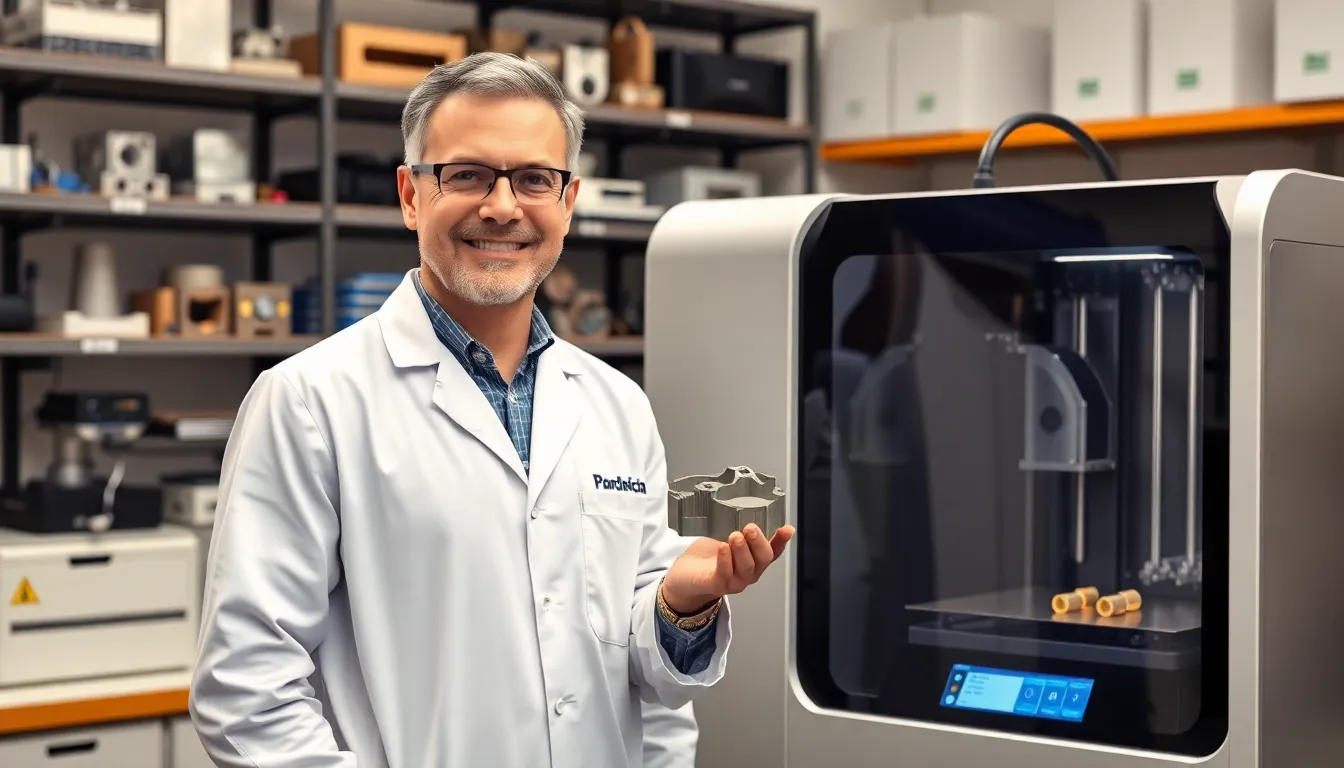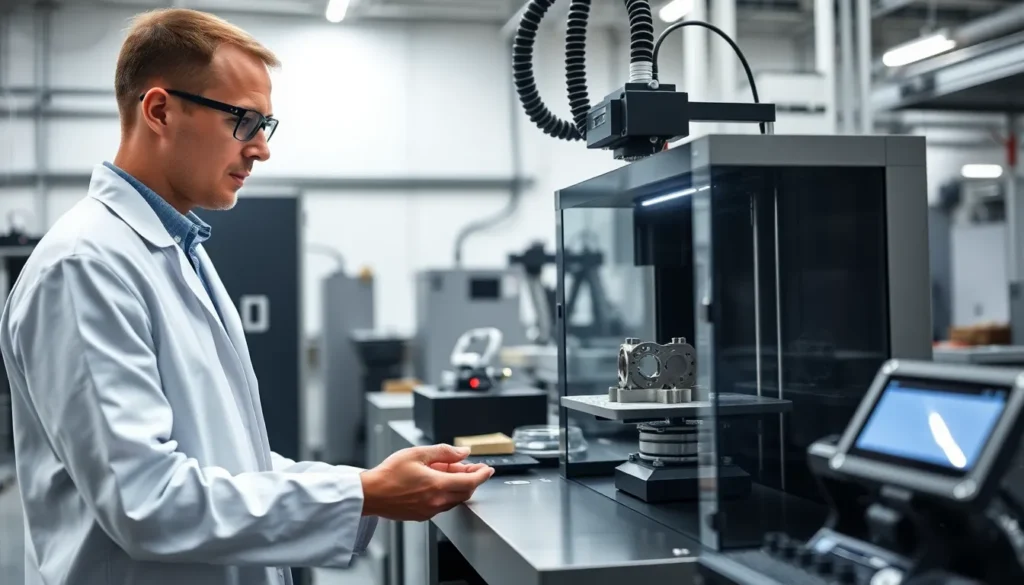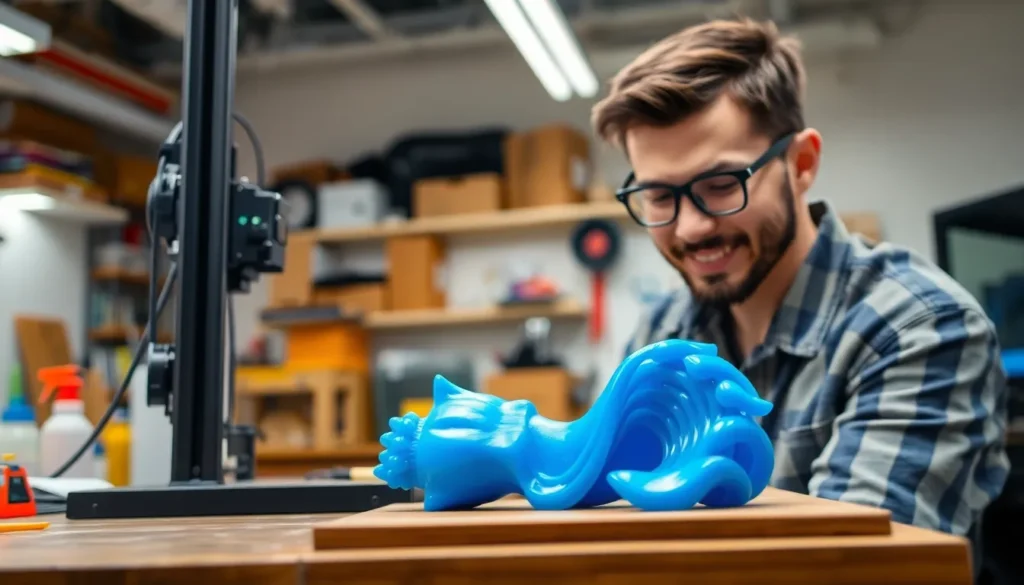In the world of manufacturing, titanium 3D printing stands out like a unicorn at a dog show. This cutting-edge technology isn’t just a passing trend; it’s revolutionizing industries by creating lightweight, durable parts that can withstand the toughest conditions. Imagine crafting intricate designs that not only look cool but also perform like a champ.
Table of Contents
ToggleOverview of Titanium 3D Printing
Titanium 3D printing plays a crucial role in modern manufacturing processes. This innovative technology utilizes titanium powder as the primary material, offering numerous advantages over traditional methods. Lightweight properties make titanium an ideal choice for various sectors, including aerospace, automotive, and medical.
High strength-to-weight ratios enable engineers to design components that reduce overall mass without sacrificing durability. Parts created with titanium 3D printing often withstand extreme environments, making them valuable for critical applications. The capacity for producing complex geometries allows for designs that traditional manufacturing cannot achieve, enhancing performance and aesthetics.
The process commonly employs Selective Laser Melting (SLM) or Electron Beam Melting (EBM) techniques. SLM uses a laser to fuse titanium powder layer by layer, while EBM employs high-energy electron beams. Both techniques ensure precision and excellent material properties, which result in superior mechanical performance.
Surface finish and post-processing impact the final quality of titanium parts. Often, printed components require processes like machining or polishing to refine surface quality and improve functionality. Due to the costs associated with titanium materials and processing, careful consideration of design is vital for maximizing efficiency.
Recent advancements continue to drive the growth of titanium 3D printing. Research focuses on optimizing parameters to enhance production speeds and reduce costs. Innovations in alloy development expand the range of applications, making titanium even more versatile in manufacturing. This technology’s continued evolution holds promise for future applications in diverse industries.
Advantages of Titanium 3D Printing

Titanium 3D printing offers numerous benefits that enhance its use across various industries. Key advantages include lightweight and strong materials, as well as design flexibility and complexity.
Lightweight and Strong Materials
Titanium exhibits a high strength-to-weight ratio, making it an ideal choice for applications requiring durable yet lightweight components. Aerospace parts, for instance, leverage this characteristic to improve fuel efficiency and performance. In the medical field, lightweight titanium implants support better patient outcomes due to reduced physical burdens. Additionally, the ability to withstand extreme temperatures and corrosion further enhances the material’s appeal for demanding environments. Therefore, manufacturers prioritize titanium for critical applications.
Design Flexibility and Complexity
Titanium 3D printing enables intricate designs that traditional methods cannot easily achieve. Complex geometries and optimized structures maximize performance while minimizing material usage. The technology allows for the creation of lattice structures that provide enhanced strength without unnecessary weight. Moreover, designers can integrate features directly into parts, reducing assembly time and costs. As a result, industries increasingly embrace titanium 3D printing to fulfill unique design requirements efficiently.
Applications of Titanium 3D Printing
Titanium 3D printing serves various industries, revolutionizing designs and enhancing performance. Its lightweight and durable nature proves beneficial across multiple sectors.
Aerospace Industry
Aerospace significantly benefits from titanium 3D printing. Manufacturers use the technology to produce lightweight components that improve fuel efficiency. Complex geometries enable engineers to create intricate parts, which reduce overall weight without compromising strength. Components like turbine blades and structural parts demonstrate exceptional performance in high-stress environments. This capability to create custom, high-performance parts enhances aircraft efficiency and supports the development of next-generation aerospace technology.
Medical Implants
Medical implants leverage titanium 3D printing for personalized designs. Implants such as joint replacements and dental fixtures demand specific shapes for optimal fit and function. Tailoring designs to individual patients improves surgical outcomes and recovery times. Moreover, the biocompatibility of titanium ensures that these implants integrate well with human tissue. The manufacturing precision allows for the creation of porous structures, promoting bone growth and enhancing implant stability. These advancements in medical applications lead to better patient care and innovative treatment options.
Automotive Sector
The automotive sector embraces titanium 3D printing for lightweight components that enhance vehicle performance. This technology allows manufacturers to create complex parts, reducing assembly time and cost. Applications include engine components and suspension parts, where strength and weight savings are critical. Using titanium also improves corrosion resistance, extending the lifespan of automotive parts. The combination of advanced materials and innovative designs supports the industry’s push toward more fuel-efficient and high-performance vehicles.
Technologies Used in Titanium 3D Printing
Titanium 3D printing employs advanced technologies to create high-performance parts with precision. Two primary techniques dominate the field: Selective Laser Melting and Electron Beam Melting.
Selective Laser Melting (SLM)
Selective Laser Melting utilizes a high-powered laser to fuse titanium powder into solid structures. The process begins with the application of a thin layer of powder onto a build platform. A laser scans the layer, melting the powder in predetermined patterns. After each layer solidifies, the platform lowers, and the cycle repeats. This technique excels in producing complex geometries while ensuring detailed surface finishes. It’s particularly favorable in aerospace applications, where performance and weight are critical. Numerous studies highlight the ability of SLM to achieve finer resolution and superior mechanical properties compared to other methods.
Electron Beam Melting (EBM)
Electron Beam Melting employs an electron beam as its primary heat source. First, a vacuum chamber creates the ideal conditions for the process. The accelerator directs the beam to selectively melt titanium powder layer by layer. This method enhances the material’s density, resulting in improved mechanical characteristics. EBM operates at elevated temperatures, allowing for the use of reactive materials without oxidation concerns. As a result, this technique is well-suited for aerospace and biomedical applications. Research demonstrates that EBM can significantly reduce residual stresses in parts, enhancing overall performance.
Challenges in Titanium 3D Printing
Titanium 3D printing faces several challenges that impact its widespread adoption in manufacturing.
Cost and Material Availability
Costs associated with titanium materials hinder the growth of titanium 3D printing. Titanium powder commands a premium price compared to traditional metals, directly affecting overall production expenses. Raw material sourcing can also present difficulties, as titanium extraction processes are complex and energy-intensive. Additionally, limited suppliers contribute to supply chain issues, leading to fluctuations in availability. Manufacturers often consider these factors when evaluating the feasibility of titanium for specific applications.
Printing Process Limitations
Limitations in the printing process can constrain the efficiency of titanium 3D printing. The thermal properties of titanium necessitate careful control of printing parameters to avoid defects, such as warping or residual stresses. Adjusting layer thickness and cooling rates requires expertise and can vary significantly among different systems, complicating production consistency. Some technologies, like SLM and EBM, have set parameters that can restrict design complexity. Moreover, lengthy build times for large parts can impede the manufacturability of intricate geometries, impacting project timelines.
Titanium 3D printing stands at the forefront of modern manufacturing, offering unmatched advantages in strength, weight, and design flexibility. As industries continue to embrace this innovative technology, the potential for groundbreaking applications grows. From aerospace to medical implants, the ability to create complex geometries and lightweight components is transforming how products are designed and produced.
Despite challenges like high material costs and process complexities, ongoing advancements promise to enhance production efficiency and broaden the scope of titanium 3D printing. The future looks bright as this technology evolves, paving the way for more sustainable and high-performance solutions across various sectors.













